Indonesian cuisine is a celebration of vibrant flavors, complex textures, and unique culinary techniques that are a testament to the rich history and diverse culture of the Indonesian archipelago. Pepes Tahu is a beloved and flavorful choice among the many dishes representing this colorful food culture. Pepes Tahu, which translates to “steamed tofu in banana leaves,” combines tofu with a fragrant mixture of herbs, spices, and seasonings, all wrapped in banana leaves and then steamed. This dish offers a perfect balance of savory and spicy flavors and reflects the ingenuity of Indonesian cooking in its simplest and most delicious form.
Table of Contents
One of the key ingredients in this Pepes Tahu recipe is daun kemangi (lemon basil). These leaves have a distinctive feature that will add significant flavor to the dish, offering a fresh, citrusy note that perfectly complements the rich spices and tofu. However, daun kemangi can be difficult to find outside of Indonesia. If you cannot source them, don’t worry—the taste of the pepes will still be excellent if you omit this ingredient. The rest of the spices and the steaming process will ensure that the dish remains delicious, regardless of whether or not you use lemon basil.
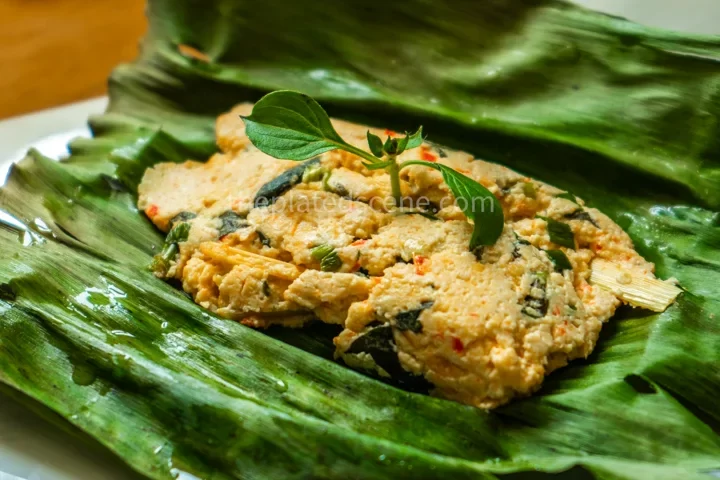
At first glance, Pepes Tahu may appear to be a modest dish, but its cultural significance goes far beyond its essential ingredients. In Indonesia, food is more than sustenance; it expresses community, identity, and tradition. Pepes Tahu is a prime example of how a dish can transcend generations, with variations passed down through families for centuries. This dish, which is deeply ingrained in the culinary practices of the Sundanese and Javanese regions, showcases how simple ingredients like tofu, herbs, and spices can come together to create something truly exceptional.
The Origins and Evolution of Pepes Tahu
To understand the true essence of Pepes Tahu, it’s essential to explore its origins and how it has evolved. The name “pepes” refers to the traditional Indonesian method of preparing food by wrapping it in leaves, usually banana leaves, and then steaming, grilling, or baking it. This method is a quintessential part of Indonesian cooking, with roots in the country’s long history of utilizing natural materials and local ingredients to prepare flavorful meals. The technique was initially developed as a practical solution for preserving food without refrigeration, allowing meals to stay fresh longer.
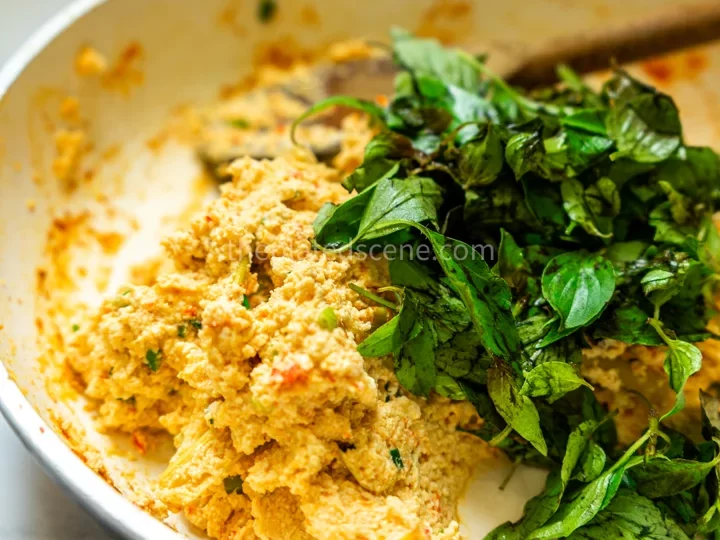
Historically, pepes was primarily used for fish and meat, as the banana leaves helped keep the food moist while locking in flavors. Over time, however, this cooking method found its way into preparing plant-based dishes, especially in regions where vegetarianism is prevalent, such as in Bali and parts of Java. Introducing tofu into the pepes technique, creating what is now known as Pepes Tahu, marked a new era of Indonesian vegetarian cooking, with tofu becoming a central ingredient in many homes due to its versatility, nutritional value, and affordability.
In the case of Pepes Tahu, tofu serves as the perfect vehicle for absorbing the vibrant flavors of the accompanying spices and herbs. While the dish is now commonly made with tofu as the main ingredient, variations do exist, where the tofu may be complemented with vegetables, tempeh, or even meat, depending on the region and the personal preferences of the cook.
The Cultural Significance of Pepes Tahu
In Indonesia, food has always been an integral part of social and cultural life. Meals are not only about eating; they are about sharing, connecting, and celebrating. Pepes Tahu is often made for family gatherings, religious ceremonies, or festive occasions, where cooking and eating bring people closer. The dish is commonly found in both everyday meals and special occasions, making it a symbol of togetherness.
In particular, Pepes Tahu holds a special place in the Sundanese and Javanese cultures. The Sundanese people, who are native to the West Java region, have a deep appreciation for fresh ingredients and bold flavors, and Pepes Tahu is an expression of this culinary tradition. Similarly, in Javanese culture, food preparation is seen as an act of reverence, with ingredients selected with care and dishes prepared to honor both family and guests. The aromatic spices used in Pepes Tahu reflect the balance of flavors central to Javanese cuisine, where the combination of sweet, savory, and spicy is key to achieving culinary harmony.
The communal aspect of Pepes Tahu is also a testament to the importance of food in building relationships. The process of wrapping the tofu and spices in banana leaves, steaming them, and then sharing the dish with others highlights the deep connection between food and community. In Indonesian culture, meals are often seen as a time to bond with family and friends, and dishes like Pepes Tahu play a central role in fostering these bonds.
The Versatility of Pepes Tahu
One of the most remarkable aspects of Pepes Tahu is its versatility. While the traditional recipe relies on tofu as the primary ingredient, Pepes Tahu can be easily adapted to suit a wide variety of tastes and dietary needs. For those who prefer plant-based meals, Pepes Tahu offers a satisfying and nutritious option, with tofu providing a healthy source of protein. For meat lovers, the dish can be made with additional ingredients like tempeh or even minced chicken or beef, offering a hearty and flavorful alternative.
In addition to tofu, other ingredients can be incorporated into the recipe to enhance both flavor and texture. Vegetables such as green beans, carrots, mushrooms, and spinach can be added to the tofu mixture, creating a more vibrant and colorful dish. These additions make Pepes Tahu more nutritious and offer an opportunity to experiment with different textures and flavors.
The spiciness of Pepes Tahu can also be adjusted to suit personal preferences. Some might prefer a milder version, using fewer chilies or omitting them altogether, while others might enjoy a bolder, spicier kick. By varying the amount and type of chili used, cooks can create different flavor profiles, from a mild and aromatic dish to a fiery, intense one.
Health Benefits of Pepes Tahu
In addition to its fantastic flavor, Pepes Tahu also boasts numerous health benefits. Tofu, the dish’s star ingredient, is a powerhouse of nutrition. Rich in protein, calcium, and iron, tofu is an excellent meat alternative for vegetarians and vegans, providing essential nutrients that support bone health, muscle function, and overall well-being. It is also low in saturated fats, making it a heart-healthy choice.
The spices used in Pepes Tahu are not just for flavor; they also bring a wealth of health benefits. Turmeric, a key ingredient, is widely recognized for its anti-inflammatory properties and its ability to promote digestive health. Garlic, another staple in the dish, has been used for centuries for its immune-boosting and antioxidant properties. Ginger, which adds warmth and spice to the dish, is known for its digestive benefits and its ability to reduce nausea and inflammation.
By combining tofu with these health-boosting spices and steaming the dish in banana leaves, Pepes Tahu becomes not only a flavorful meal but also a nutritious one, offering a variety of health benefits that support a balanced and healthy lifestyle.
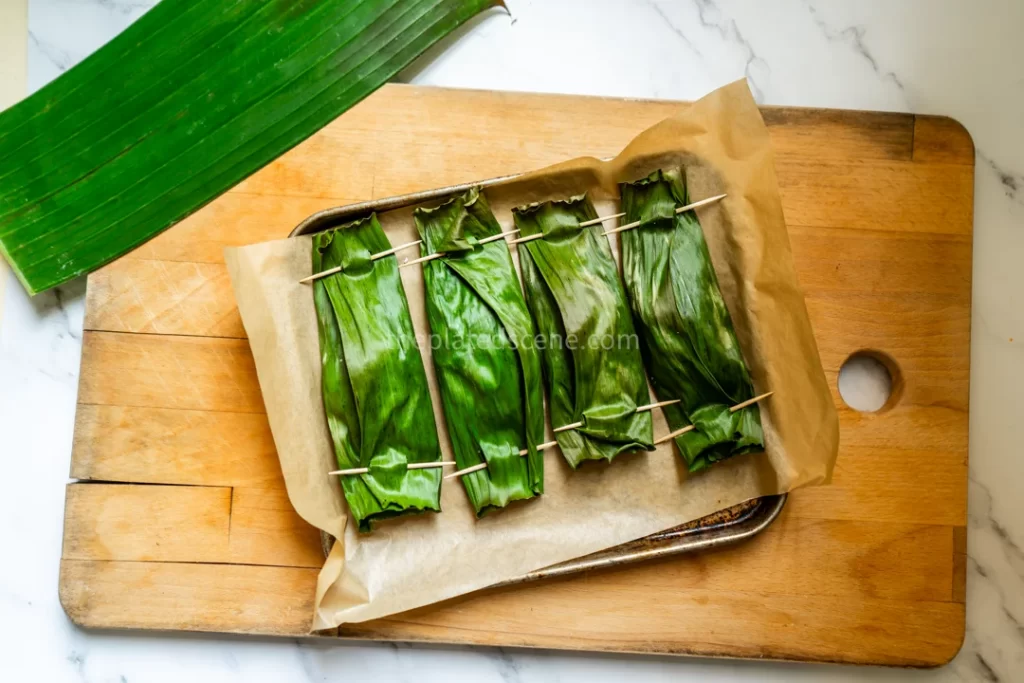
Moreover, Pepes Tahu is often served with various accompaniments, allowing for even more versatility in how the dish is enjoyed. It pairs perfectly with steamed rice, nasi goreng (fried rice), or a light cucumber salad. For those who want a bit of heat, Pepes Tahu can be accompanied by sambal, a traditional Indonesian chili paste that adds an extra layer of flavor and spice.
A Dish for the Modern Palate
Despite its long history, Pepes Tahu remains a relevant and popular dish in modern Indonesian kitchens. In recent years, as more people adopt plant-based diets and seek out healthier meat alternatives, Pepes Tahu has gained renewed popularity. It’s a satisfying and nourishing dish, appealing to those looking for a wholesome, meat-free meal that doesn’t compromise on flavor.
The dish’s ability to be customized to suit various tastes, dietary needs, and preferences ensures that it remains a beloved choice across generations. Whether enjoyed as a main course, a side dish, or a snack, Pepes Tahu is a perfect example of how traditional Indonesian cooking techniques can be adapted to the modern kitchen, offering a timeless flavor that resonates with today’s health-conscious and adventurous eaters.
Essential Ingredients for Pepes Tahu
Pepes Tahu is a beloved dish in Indonesian cuisine, and its key ingredients work together to create a rich and aromatic flavor profile. Each ingredient is crucial in crafting the perfect pepes tahu, from tofu to fresh herbs and spices. The balance of savory, spicy, and fresh flavors makes this dish unique and delicious. Let’s look at the essential ingredients that make pepes tahu so special.
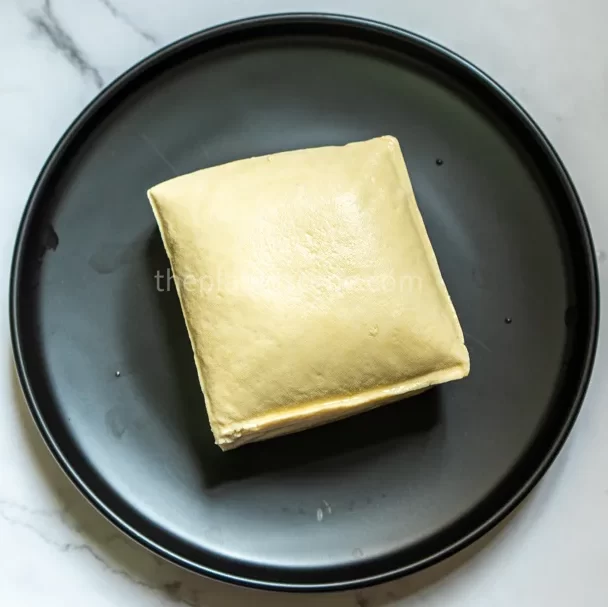
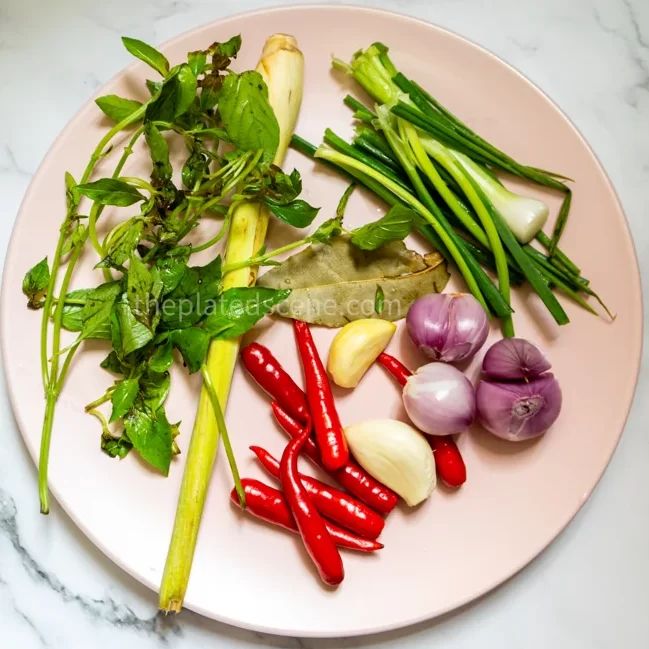
Tofu (Tahu)
The tofu is at the heart of pepes tahu, and choosing the right variety is essential for the perfect texture. For this recipe, semi-firm tofu is the best choice. It holds its structure well during steaming, ensuring it doesn’t fall apart inside the banana leaves. Semi-firm tofu is also ideal for absorbing the rich spices and flavors from the other ingredients, making it a perfect base for pepes tahu.
To achieve the best results, pressing the tofu to remove excess water is essential. Pressing helps the tofu absorb more of the spice paste, key to achieving the bold, savory flavor in every bite. This tofu will blend seamlessly with the other ingredients, creating a satisfying texture and flavor profile.
Shallots & Garlic
Garlic and shallots are foundational in Indonesian cuisine and play an essential role in pepes tahu. They create the flavor base for the spice paste that will coat the tofu. Shallots offer a mild sweetness that complements garlic’s rich, savory taste. Together, they form a powerful duo that enhances the overall dish.
In Indonesian cooking, garlic and shallots are like the “Maradona to soccer” — an iconic pairing that elevates the dish’s flavor. Their fragrant and aromatic qualities are essential in creating the savory base that gives pepes tahu its characteristic depth. Sautéing these ingredients first allows them to release their natural oils, creating a fragrant paste that infuses the tofu with their flavor.
Chilies
Chilies are an optional but essential ingredient in pepes tahu for those who enjoy a bit of spice. Depending on your heat tolerance, add as many chilies as you like. The heat from the chilies balances the richness of the tofu and the aromatic spices, adding a layer of intensity to the dish.
If you’re not a fan of spicy food, don’t worry—you can easily omit the chilies, and pepes tahu will still be delicious. The flavor of the other spices will still shine through, and you’ll enjoy the same aromatic, savory tofu without the heat. Just be sure to adjust the number of chilies based on your personal preferences for spice.
Fresh Lemongrass
Lemongrass is a key ingredient in pepes tahu, contributing its fresh, citrusy flavor with hints of ginger. This aromatic herb is essential in giving pepes tahu its distinct brightness and freshness. To prepare lemongrass, cut it into 2- to 3-inch lengths and then bruise it by bending it several times. Bruising the lemongrass helps release its essential oils, infusing the tofu mixture with its signature lemony aroma.
Lemongrass adds a refreshing note that complements the deeper, more decadent flavors of the garlic, shallots, and other spices in pepes tahu. It also subtly contrasts the richness of the tofu, balancing the dish with its zesty fragrance.
Bay Leaves (Daun Salam)
In pepes tahu, daun salam (salam leaves) is used to enhance the savory flavor of the dish. While bay leaves are often used as a substitute in other recipes, daun salam offers a unique, sweet-savory flavor that complements the aromatic spices. These leaves provide a subtle, earthy fragrance that infuses the tofu mixture, enriching the overall taste.
If daun salam is not available, you can use dried bay leaves as a substitute. However, the distinctive flavor of daun salam is part of what makes pepes tahu so uniquely Indonesian. Whether you use daun salam or bay leaves, both will help deepen the dish’s flavor profile.
Green Onions (Daun Bawang)
Green onions are another key ingredient in pepes tahu, adding flavor and texture to the dish. The white part near the roots offers a sharp, pungent onion flavor that helps bring out the richness of the other ingredients. The green leafy part of the green onion has a milder, sweeter taste and provides a crisp texture that balances the soft tofu mixture.
Both parts of the green onion are used in pepes tahu, contributing to the dish’s complexity. Thinly slicing the green onions allows them to distribute evenly throughout the tofu mixture, enhancing the overall flavor and adding a bit of crunch to each bite.
Daun Kemangi (Lemon Basil)
One of the most aromatic herbs in pepes tahu is daun kemangi (lemon basil). This herb adds a fresh, citrusy fragrance that enhances the overall aroma of the dish. The lemony scent of daun kemangi complements the rich flavors of the tofu and the aromatic spices, creating a complex and balanced flavor profile.
While daun kemangi is an essential ingredient in traditional pepes tahu, it cannot be found easily outside of Indonesia. If you cannot find it, don’t worry—pepes tahu will still taste delicious without it. The other ingredients will still provide plenty of flavor, and you can substitute other fresh herbs, such as Thai basil, if available.
Banana Leaves (Daun Pisang)
Banana leaves are indispensable in preparing pepes tahu, as they help retain the tofu’s moisture during steaming. Not only do the leaves keep the tofu moist, but they also impart a subtle, earthy aroma that adds depth to the dish. The banana leaves provide a natural wrapper that holds the mixture together while it steams, ensuring the spices infuse the tofu evenly.
To use banana leaves, you should soften them first by briefly passing them over an open flame or blanching them in hot water. This will make the leaves more pliable and easier to fold around the tofu. The banana leaves also help preserve the dish’s delicate flavors, keeping everything intact while steaming.
Toothpicks
Toothpicks are a simple yet essential tool for securing the banana leaves around the tofu mixture. They help fasten the leaves, preventing them from unraveling during steaming. Using toothpicks ensures that the banana leaves stay securely wrapped around the tofu, allowing it to cook evenly and absorb all the wonderful flavors from the spices and herbs.
Cooking Oil, Salt, and Mushroom Stock
A small amount of cooking oil is used to sauté the shallots, garlic, and spices, releasing their natural oils and flavors. Salt is added to balance the dish’s richness, bringing the flavors together. Mushroom stock (or vegetable stock) adds depth and umami to the tofu mixture, making each bite savory and satisfying. This oil, salt, and stock combination ensures the tofu is perfectly seasoned and flavorful.
Let’s Start Making the Pepes Tahu
Making Pepes Tahu is an art that combines aromatic spices, tofu, and banana leaves. The process might seem involved, but it’s pretty straightforward once you get the hang of it. From blending the tofu mixture to wrapping it in banana leaves and baking it, each step adds layers of flavor, culminating in an aromatic, flavorful, and comforting dish. Let’s break down the process so you can make the perfect Pepes Tahu at home.
1. Preparing the Tofu Mixture for Pepes Tahu
The first step in making Pepes Tahu is to prepare the tofu mixture. Start by breaking the firm tofu into large chunks. Firm tofu is preferred here because it holds its shape well and offers a dense texture, making the pepes more satisfying. Once the tofu is broken into chunks, please place it in a blender or food processor. You can use an immersion blender (I use a Braun immersion blender with its 350ml chopper attachment), but any good-quality blender will do the job.
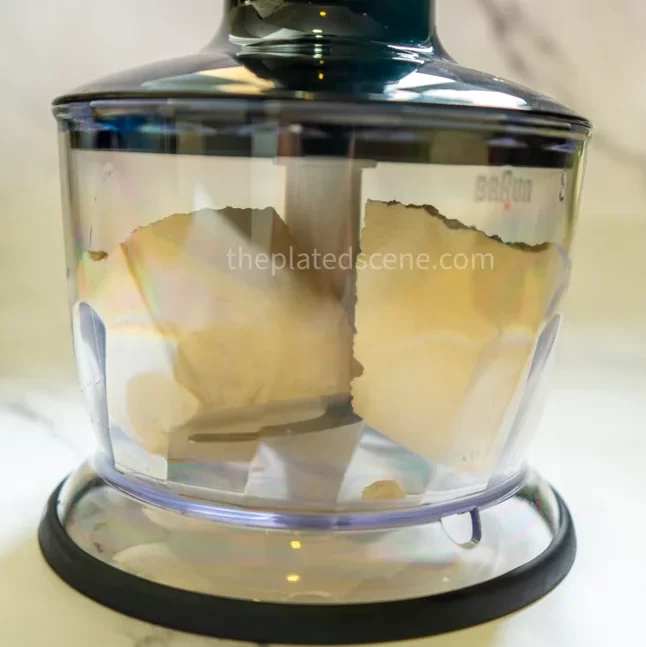
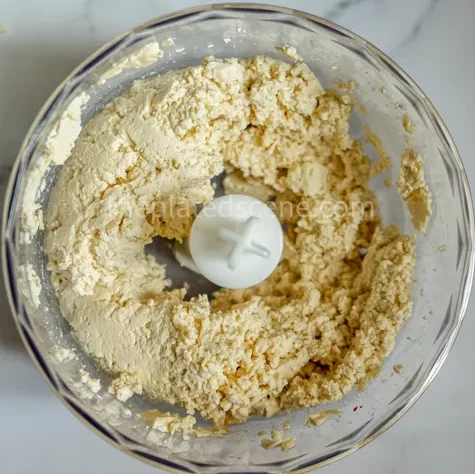
Blend the tofu until it reaches a smooth, creamy consistency. You want it to resemble a thick paste that is easy to mix with the spices and herbs later. The texture is key here—too coarse, and it won’t mix well with the other ingredients; too smooth, and it may lack the heartiness that tofu is known for in Pepes Tahu. After blending, transfer the tofu mixture into a large bowl and set it aside while you prepare the aromatic spices.
2. Preparing the Spice Paste for Pepes Tahu
The spice mixture is what gives Pepes Tahu its distinctive flavor. The next step is to combine your garlic, shallots, chilies, salt, and mushroom stock in a bowl. These ingredients form the backbone of the spice paste. The garlic and shallots will create a savory, aromatic base, while the chilies (if you choose to use them) add a bit of heat. The salt brings out the flavor of the other ingredients, and the mushroom stock adds a rich, umami depth to the dish.
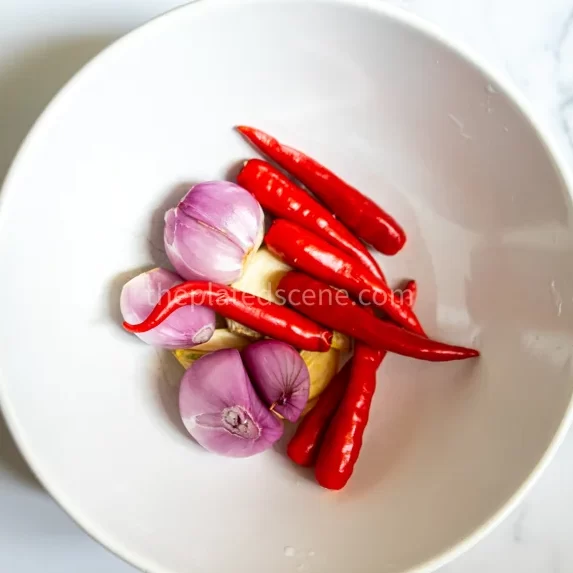
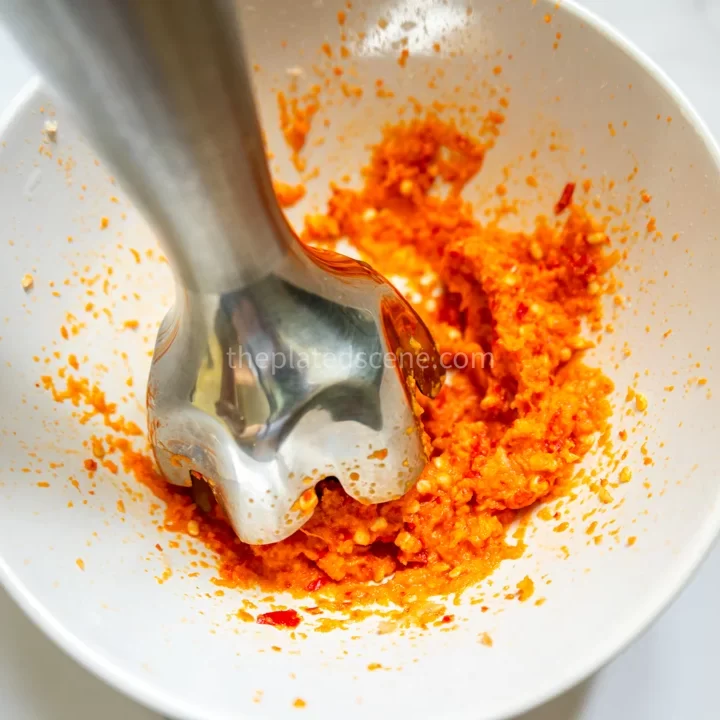
Once the ingredients are in the bowl, blend them finely using your hand or immersion blender. The goal is to create a smooth paste that can easily coat the tofu. This blending step is essential because it allows the garlic, shallots, and spices to combine and meld into a flavorful paste that will infuse the tofu with all the complex, aromatic flavors typical of Pepes Tahu.
3. Cooking the Spice Paste and Mixing with Tofu
Now that the spice paste is ready, it’s time to cook it and combine it with the tofu. Heat a medium-sized pan over medium heat and add a small amount of cooking oil. Once the oil is hot, add the blended garlic, shallots, and chilies to the pan. At this stage, you should start to smell the fragrant aroma of the garlic and shallots releasing their oils. Stir constantly to avoid burning the paste.
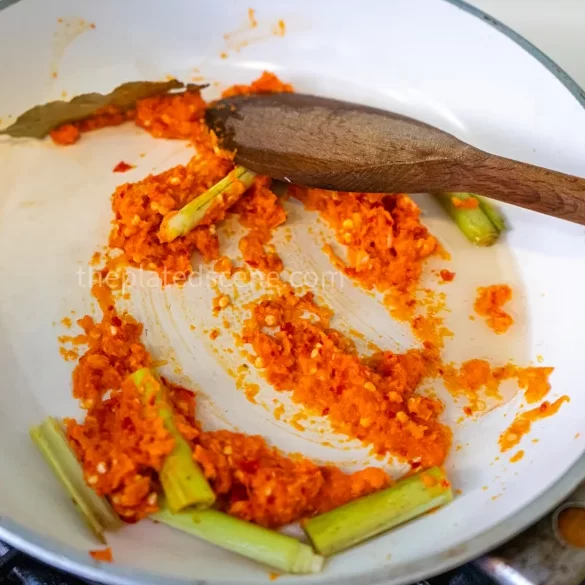
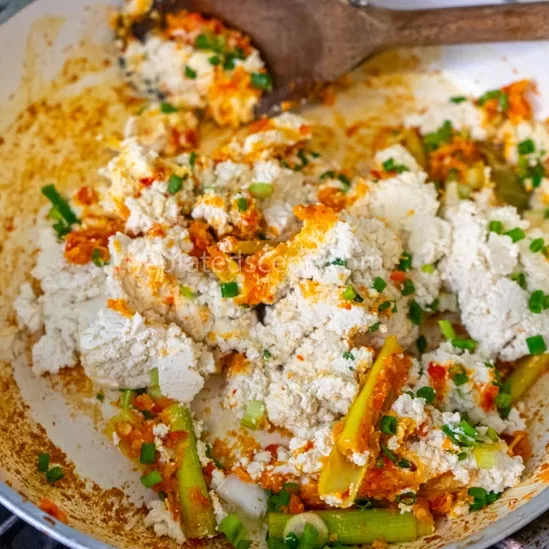
After a few minutes, add the lemongrass and bay leaves. Lemongrass adds a refreshing citrusy flavor with a hint of ginger, while bay leaves contribute a subtle earthy, aromatic note. Combining these two ingredients will intensify the flavors of the pepes as they cook. Keep stirring the mixture and cook it for about 5 minutes, or until the “garlicky” smell has disappeared and the paste becomes fragrant.
Once the spice paste is cooked and the aromatic oils are released, turn off the heat and add the blended tofu mixture to the pan. This is when the magic happens: mix everything thoroughly, ensuring the tofu is evenly coated with the spice paste. The heat from the paste will begin to infuse the tofu with all the aromatic flavors you’ve worked so hard to create.
After mixing the tofu and spice paste, slice the green onions thinly and add them to the tofu mixture. The green onions will add a bit of fresh, sharp flavor and a slight crunch, balancing the richness of the tofu. Mix it all, and you’ll have a beautiful, fragrant, spiced tofu mixture ready for wrapping in banana leaves.
4. Adding Daun Kemangi (Lemon Basil) and Final Mixing
It’s time to add the final touch: daun kemangi (lemon basil). Daun kemangi is a fragrant herb that adds a fresh, citrusy flavor, perfectly complementing the other spices in Pepes Tahu. If you’ve managed to find it, tear the leaves off the stem and add them to the tofu mixture, mixing it in well. If you can’t find daun kemangi, don’t worry—the pepes tahu will still taste great without it. The remaining ingredients will still bring the depth of flavor needed to create a delicious dish.
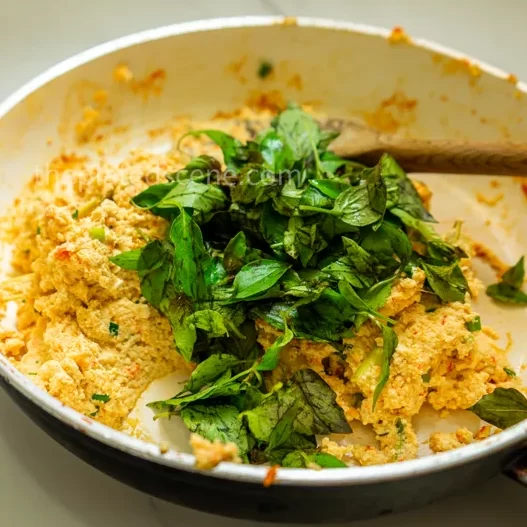
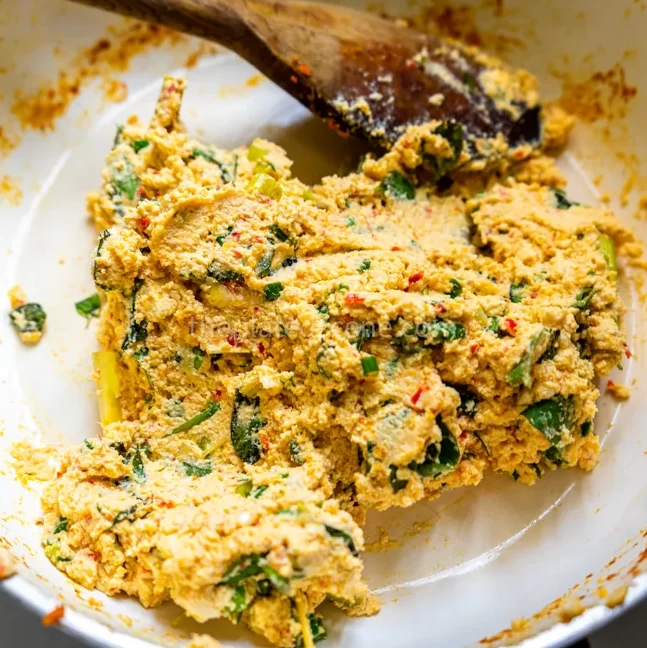
As you mix in the daun kemangi, please do not remove the lemongrass or bay leaves from the tofu mixture, as they will continue to release their aromas and flavors while the pepes bake. The leaves are important in enhancing the dish’s taste, so be sure to leave them in the mixture.
5. Pepes Wrapping Technique (Techniques 1 and 2)
Now that your tofu mixture is prepared, it’s time to wrap it up in banana leaves. The wrapping technique is crucial because it keeps the tofu moist and locked in with all the delicious flavors while it bakes. You can use two wrapping techniques—both are effective, but one may be easier depending on your skill level.
Technique 1: The Classic Wrap
Start by taking one piece of banana leaf and placing it flat with the non-shiny side facing up. Spoon a generous portion of the tofu mixture into the center of the leaf. The key to wrapping the pepes is ensuring the banana leaf is pliable enough to fold around the tofu mixture, keeping everything intact during baking. If necessary, soften the banana leaves by briefly passing them over an open flame or blanching them in hot water.
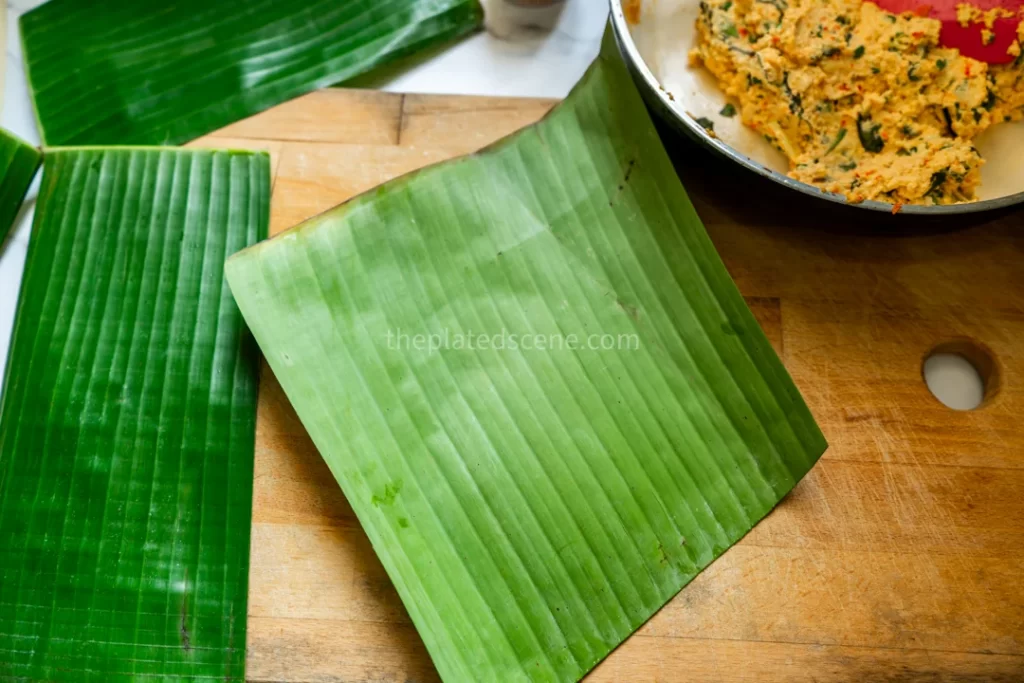
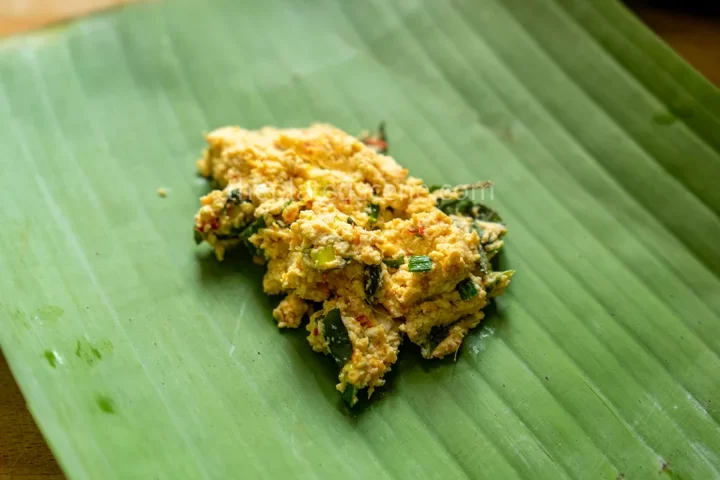
Once the tofu mixture is placed in the center, fold one-third of the banana leaf over the tofu mixture (step 3), then fold the other side (step 4), creating a neat, sealed packet. The next step is the trickiest: fold the banana leaf’s top and bottom parts over the tofu mixture (step 5), and secure the folds with a toothpick. This ensures that the banana leaf stays wrapped tightly around the tofu mixture while it bakes, trapping all the flavors.
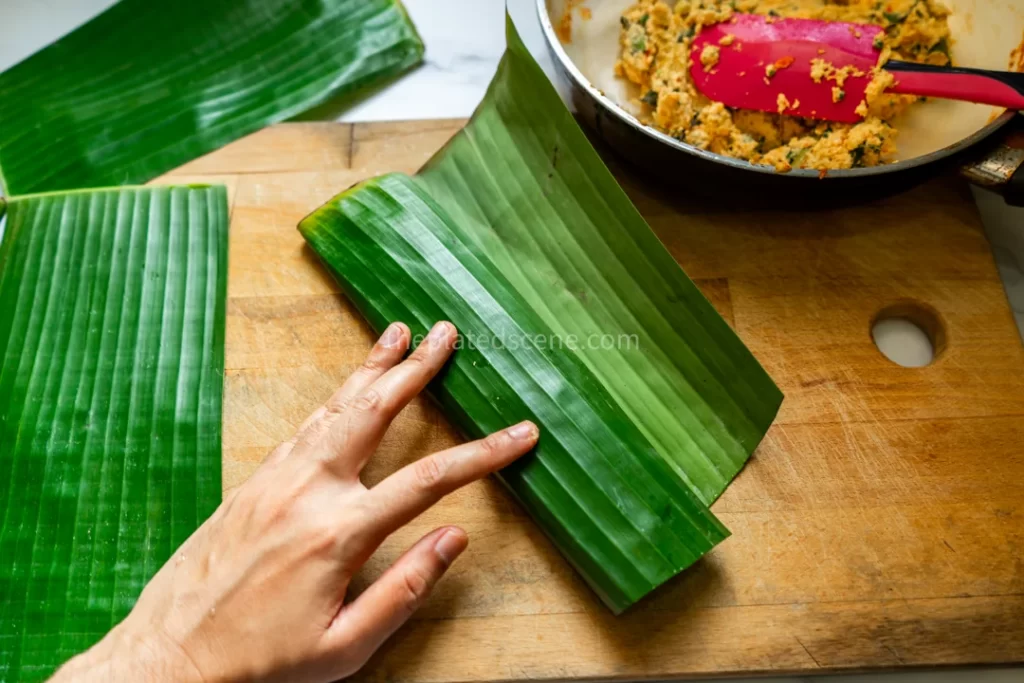
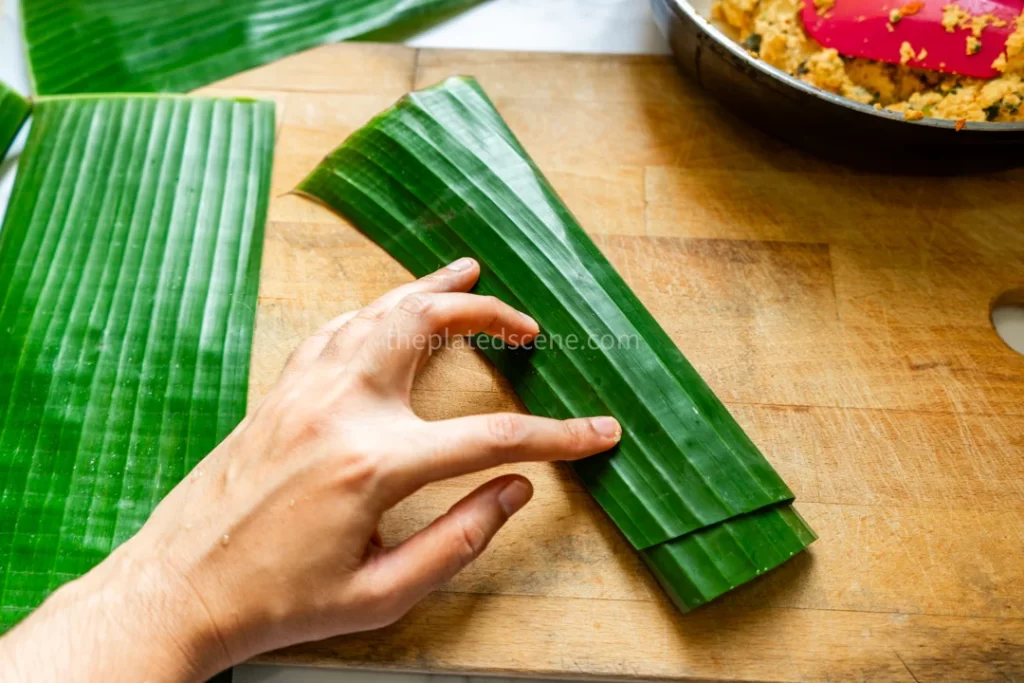
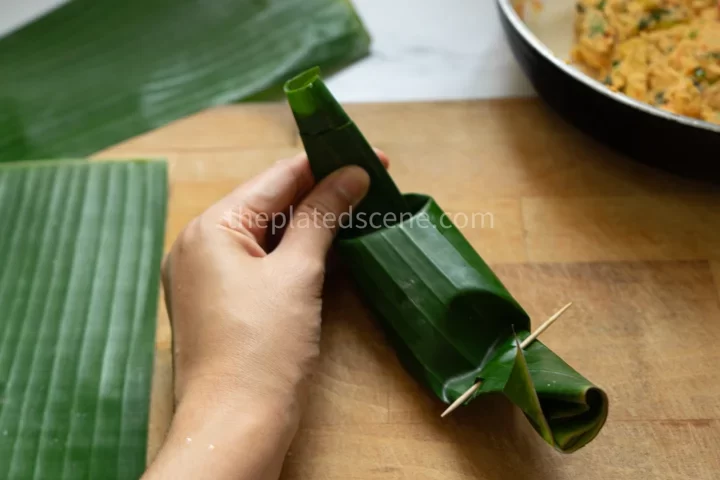
Technique 2: The Simpler Wrap
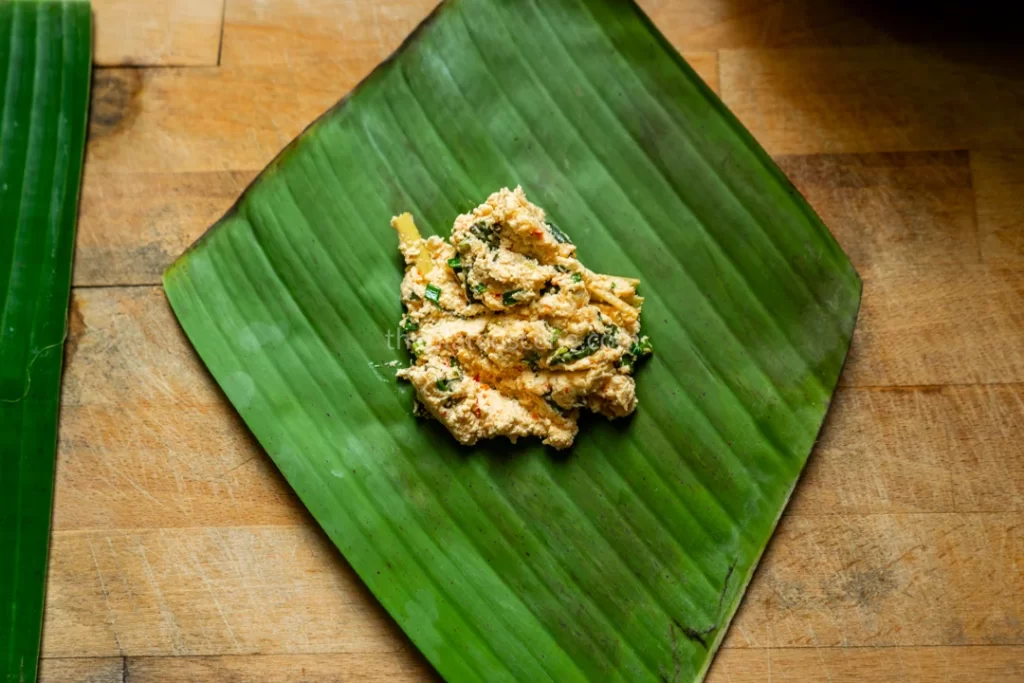
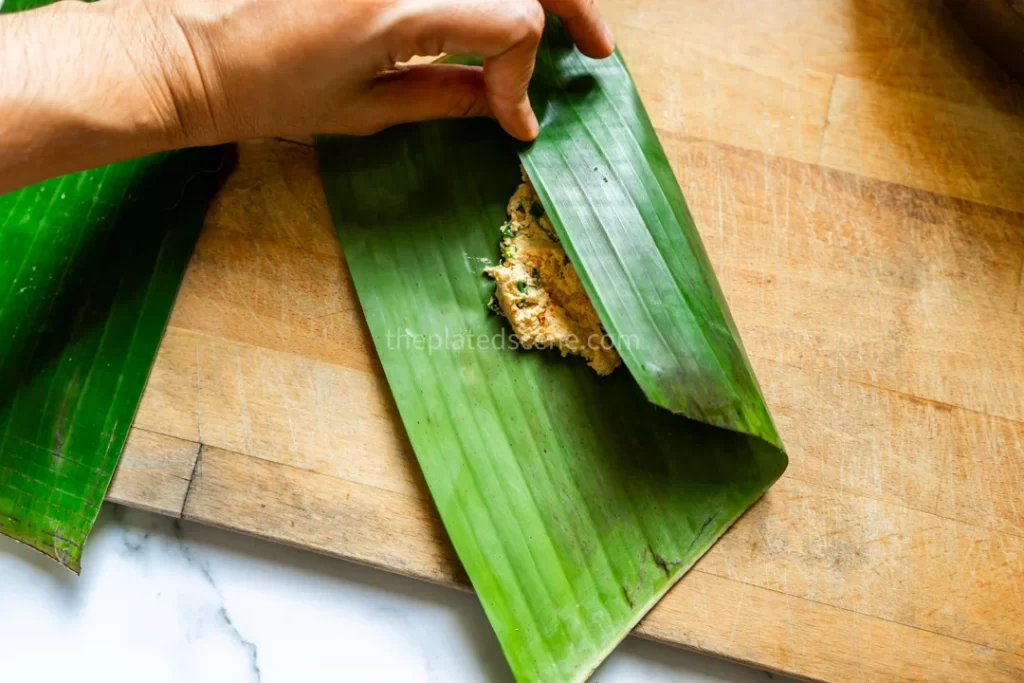
If you’re looking for a quicker and easier way to wrap the pepes, Technique 2 is a great alternative. This method is similar to Technique 1, but with fewer steps. After placing the tofu mixture in the center of the banana leaf, instead of folding the top and bottom of the leaf, fold the sides of the banana leaf over the mixture and secure the wrap with a toothpick (steps 3 and 4). This method is simpler and faster, making it a great choice if you’re short on time or prefer a less complex wrapping process.
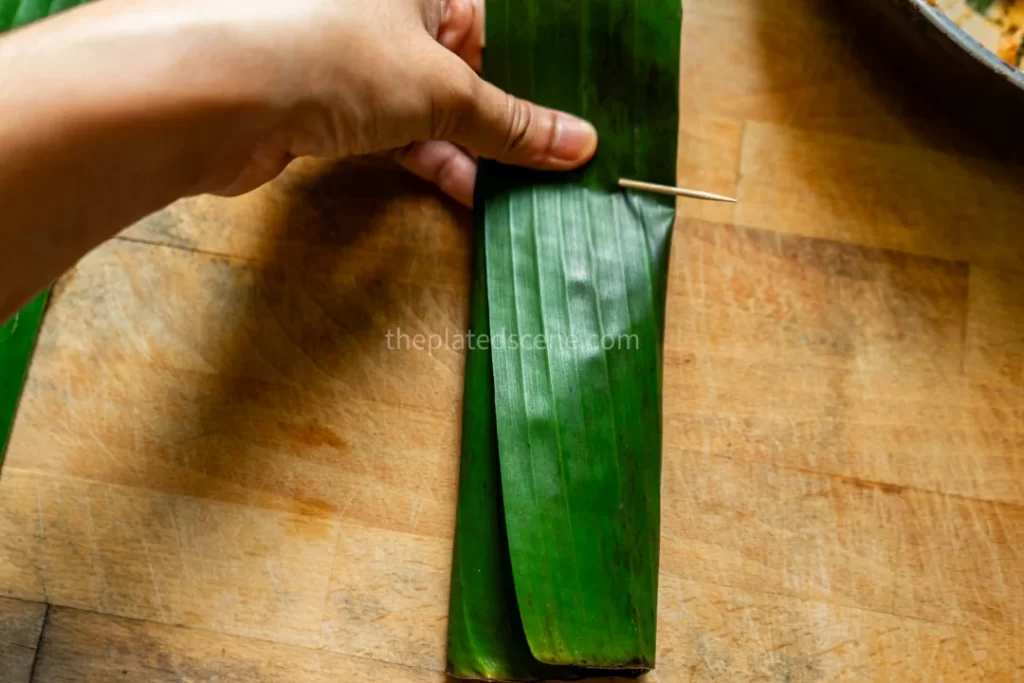
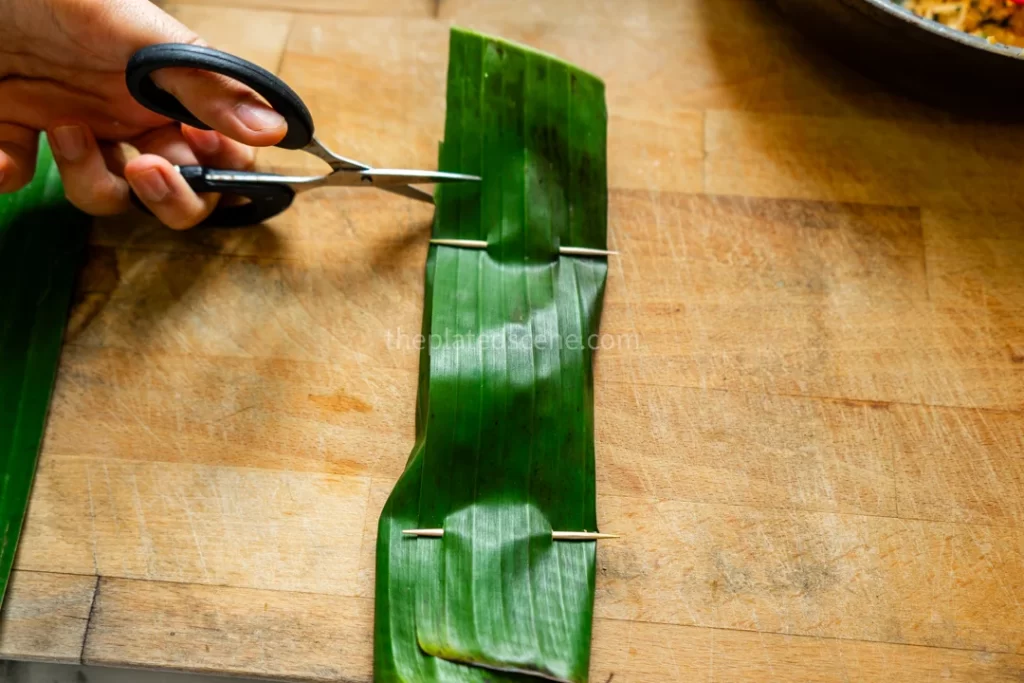
6. Baking the Pepes Tahu
Once the pepes are wrapped securely in the banana leaves, it’s time to bake them. Preheat your oven or toaster oven to about 100°C (212°F). Place the wrapped pepes tofu on a baking sheet and bake for 15-20 minutes. The banana leaves should start to darken and become fragrant as the pepes cook, and you’ll notice the tofu mixture becoming soft and fully cooked.
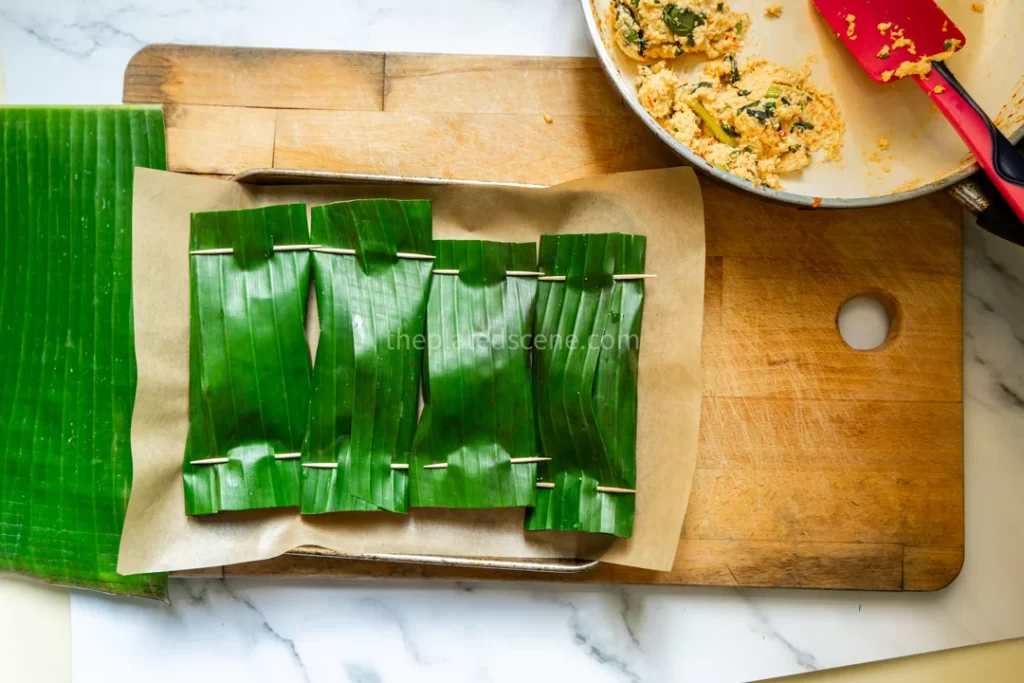

You can also bake the pepes in a regular oven if you prefer. Follow the same temperature and time guidelines, ensuring the pepes are baked until they develop a slight char and the banana leaves become aromatic. The gentle heat will allow the tofu to absorb all the spices, and the banana leaves will impart their earthy fragrance.
7. Unwrapping and Serving the Pepes Tahu
Once the pepes are done baking, remove them from the oven and carefully unwrap the banana leaves. The moment you open the wraps, you’ll be greeted by the intoxicating aroma of the spiced tofu and fresh herbs.
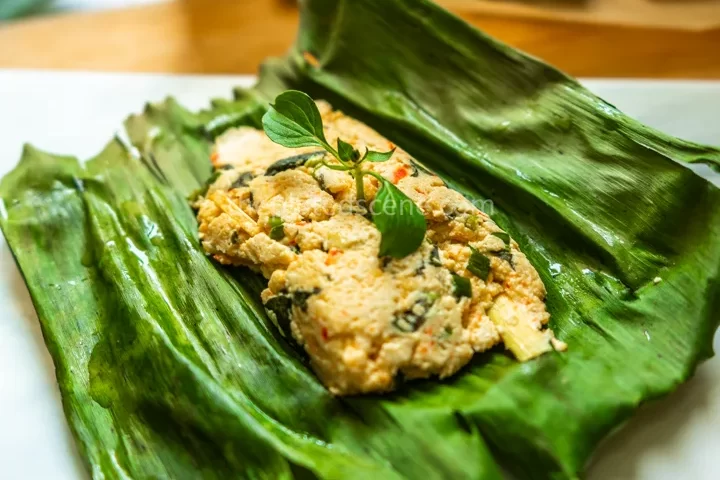
Serve your pepes tahu with warm rice, and enjoy this delicious, flavorful Indonesian dish. The tofu should be tender, infused with spices and herbs, and perfectly balanced with the freshness of the daun kemangi and green onions.
Storing and Reheating Pepes Tahu
If you have leftover Pepes Tahu or want to prepare it in advance, storing it properly ensures that it stays fresh and delicious. Here are the steps for storing your Pepes Tahu:
Storing Pepes Tahu in the Refrigerator:
- Cool the Pepes Tahu: After cooking, allow the pepes to cool to room temperature before storing. This helps prevent excess moisture from accumulating and keeps the texture intact.
- Wrap and Store: If you have any leftover Pepes Tahu in the banana leaves, you can leave them wrapped or unwrapped. If you want to preserve the freshness of the banana leaves, store them as-is in an airtight container. Alternatively, remove the banana leaves, place the tofu mixture in an airtight container, and cover it.
- Refrigeration: Store the Pepes Tahu in the refrigerator for 3 days. The tofu will continue to absorb flavors from the spices, and the dish will remain flavorful even after a couple of days.
Freezing Pepes Tahu:
If you want to store your Pepes Tahu for a more extended period, freezing is a great option:
- Prepare for Freezing: Allow the pepes to cool completely before freezing. If you have Pepes Tahu wrapped in banana leaves, you can freeze them as they are. Alternatively, transfer the tofu mixture into a freezer-safe, airtight container or freezer bag.
- Wrap and Seal: Wrap the pepes tightly to avoid freezer burn. If you’re using a container, seal it tightly before placing it in the freezer.
- Freezing Time: Frozen Pepes Tahu can be stored for up to 2 months. When ready to enjoy it, thaw in the refrigerator overnight.
Reheating Pepes Tahu:
- Thaw (if frozen): If you’ve frozen your pepes, thaw it in the refrigerator overnight before reheating.
- Reheat in the Oven: Preheat your oven to 100°C (212°F). Place the Pepes Tahu on a baking tray and bake for 10–15 minutes or until it is heated and the banana leaves become fragrant again. The gentle heat will help preserve the flavor and texture of the tofu mixture.
- Reheat in a Steamer: Alternatively, you can reheat Pepes Tahu by steaming it. If it’s wrapped in banana leaves, place it in a steamer for 10–15 minutes until heated.
- Reheat on the Stove: You can reheat Pepes Tahu in a pan on medium-low heat for a quicker option. If the tofu mixture seems dry, add a little bit of water or vegetable broth to help rehydrate the mixture while reheating.
Other recipes that you might love
- The Complete Guide to Sauté Leunca: A Culinary Gem of Indonesian Cuisine
- Ultimate Vegan Chicken Soup Recipe: Irresistibly Comforting and Packed with Bold Flavor


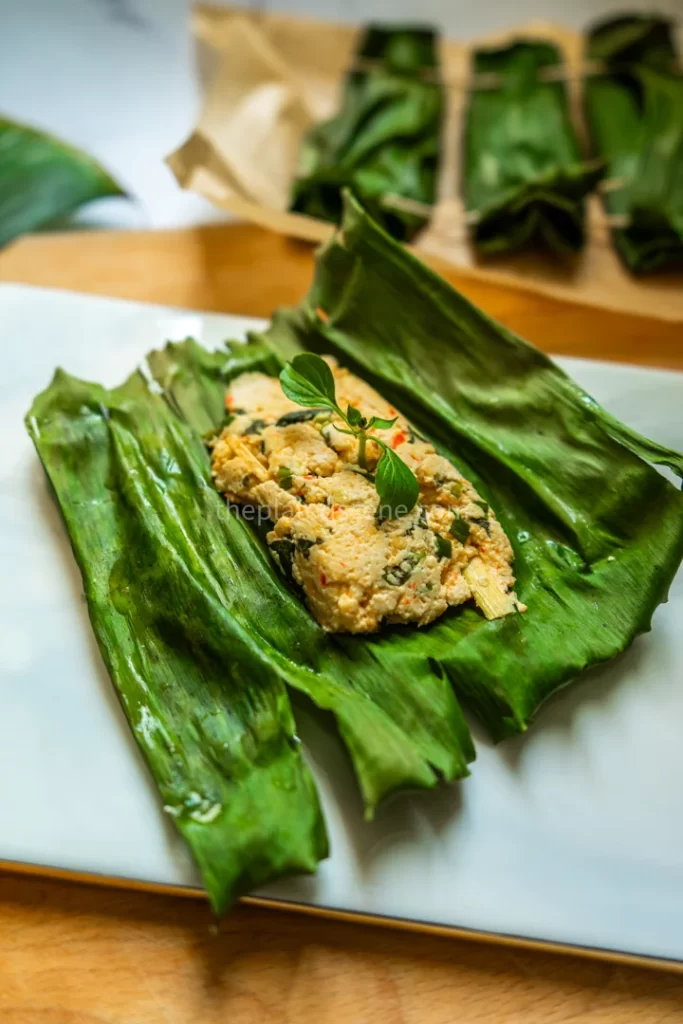
3 comments
[…] Pepes Tahu […]
[…] Spiced Tofu in Banana Leaves (Pepes Tahu) Authentic Recipe […]
[…] Spiced Tofu in Banana Leaves (Pepes Tahu) […]
Comments are closed.